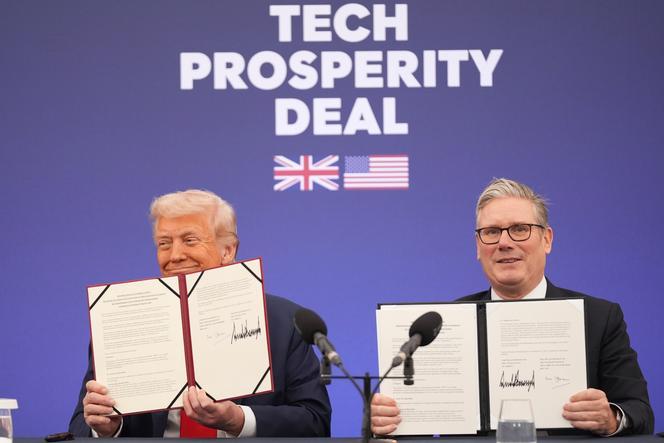The recently announced U.S.-U.K. Tech Prosperity Deal promises to accelerate innovation and bolster economic growth by deepening transatlantic cooperation in technology sectors. Yet, beneath the optimistic projections lies a complex debate over the potential trade-offs involved, particularly concerning national sovereignty. Critics warn that in pursuit of greater scale and competitiveness on the global stage, both nations may be ceding crucial control over regulatory standards, data governance, and technological autonomy. This article examines the multifaceted costs of the deal, questioning whether the promise of prosperity comes at an unacceptable price to sovereign decision-making.
Evaluating the Impact of Regulatory Alignment on National Sovereignty
The U.S.-U.K. Tech Prosperity Deal signifies a profound shift in how both countries approach governance in the digital economy. While regulatory alignment promises streamlined operations for multinational tech firms, it raises pressing questions about the erosion of national sovereignty. Key regulatory decisions on data privacy, digital security, and artificial intelligence standards are increasingly influenced by joint frameworks that prioritize cross-border efficiency over localized policy controls. This alignment may limit each nation’s ability to tailor regulations that reflect unique social values, economic priorities, or political mandates, potentially sidelining domestic interests in favor of broader, bilateral agendas.
Critical concerns emerge around transparency and accountability in this collaborative regulatory landscape. Stakeholders worry that collaborative rule-making could result in:
- Reduced parliamentary oversight, as decisions shift to intergovernmental bodies.
- Limited public participation in processes traditionally reserved for national debate.
- Favoring dominant tech industry players through harmonized standards that may marginalize smaller local enterprises.
| Aspect | National Control | Post-Alignment Influence |
|---|---|---|
| Data Privacy | High | Moderate |
| AI Ethics | Full Autonomy | Shared Standards |
| Cybersecurity Protocols | Independent | Coordinated |
As illustrated, areas once under complete national jurisdiction now occupy a middle ground, sharing regulatory authority with the partnering nation. This recalibration of power, while beneficial for facilitating trade and innovation, necessitates vigilant monitoring to ensure that sovereignty is not diminished at the expense of scale and economic gain.
Unpacking the Economic and Security Tradeoffs in the U S U K Tech Partnership
At the heart of the burgeoning U.S.-U.K. tech partnership lies a complex balancing act, where economic ambitions collide with national security concerns. While proponents hail the deal as a pathway to accelerated innovation and expanded market access, critics warn that both countries might be trading critical aspects of their sovereignty for scale. By aligning regulatory frameworks and sharing sensitive data, the alliance promises enhanced competitiveness against global tech rivals, but it also raises vital questions about oversight, transparency, and control. The partnership’s framework appears to prioritize agility and integration, potentially at the expense of independent policy-making and the protection of domestic industries.
Key considerations highlight a series of tradeoffs that stakeholders must navigate:
- Data privacy and cybersecurity risks: Increased data flow between nations could amplify vulnerabilities if not carefully managed.
- Regulatory harmonization vs. democratic governance: Streamlining rules may simplify cross-border cooperation but may limit each country’s ability to tailor laws to their populations.
- Economic dependency: Heavy reliance on transatlantic supply chains could expose both nations to geopolitical shocks.
| Aspect | Potential Benefit | Potential Risk |
|---|---|---|
| Shared Innovation | Faster R&D cycles | Loss of independent tech agendas |
| Market Access | Expanded consumer reach | Increased exposure to foreign competition |
| Security Collaboration | Enhanced threat intelligence | Joint vulnerabilities to cyberattacks |
Strategies for Balancing Innovation Growth with Protective Oversight
Achieving a sustainable balance between fostering innovation and maintaining regulatory safeguards requires a multifaceted approach. First, establishing dynamic regulatory frameworks that adapt alongside technological advancements allows oversight bodies to respond effectively without stifling creativity. Collaborative platforms that bring together policymakers, industry leaders, and civil society actors can catalyze informed decision-making, ensuring regulations are grounded in real-world technological contexts.
- Flexible policy mechanisms that evolve with emerging tech trends
- Periodic impact assessments to recalibrate oversight intensity
- Investment in regulatory tech that automates compliance monitoring
- Public-private partnerships to share expertise and risks
Moreover, transparency and accountability remain critical in this balancing act. Implementing standardized reporting and open data initiatives enhances public trust and allows stakeholders to track how innovation growth aligns with privacy, security, and ethical standards. Comparative analyses facilitate understanding where trade-offs reside and how sovereignty concerns can be safeguarded without undermining the overall scale and ambition of cross-national tech agreements.
| Strategy | Benefit | Potential Challenge |
|---|---|---|
| Adaptive Regulation | Responsive oversight | Regulatory lag |
| Stakeholder Collaboration | Inclusive policies | Conflicting interests |
| Transparency Initiatives | Public trust | Data privacy risks |
| Investment in RegTech | Efficient monitoring | Implementation costs |
Wrapping Up
As the U.S.-U.K. Tech Prosperity Deal moves from negotiation to implementation, the balance between national sovereignty and economic scale remains a critical concern. While the agreement promises expanded market access and innovation opportunities, critics warn of potential compromises to regulatory autonomy and data governance. Observers will be closely watching how both governments navigate these tensions, as the deal sets a precedent for future tech alliances in an increasingly interconnected, yet geopolitically complex, digital landscape.




